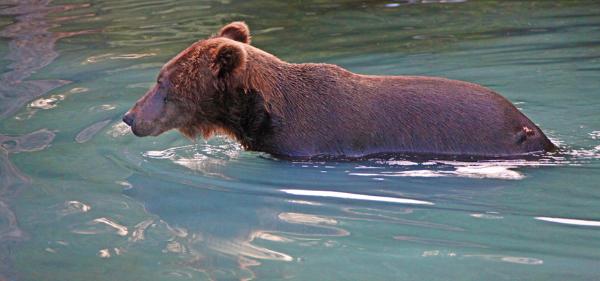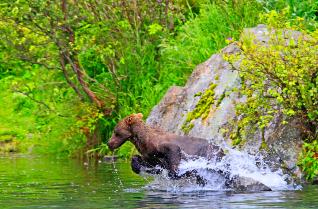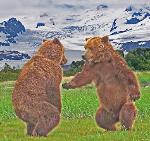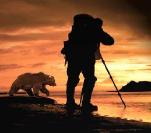Which species of bears to you want to see? There are only a few areas in North America where habitat is shared by both black
and grizzly or brown bears, or where habitat is shared by both grizzly and polar bears, but none that is shared by all three species. In
fact, most of this continent is inhabited only by black bears. Most of Europe is home only to brown bears, except in the far North
where polar bears occur. There are parts of Asia shared by brown bears and Asiatic black bears, as well as other areas shared by
Asiatic black bears and sun bears or sloth bears or panda bears. There might even be small areas shared by sun and sloth bears. The
spectacled bear of South America is the only ursid on that continent. So if you want to see a particular species, that will limit where
you can view. Click here to see photos of each species and maps of where each lives.
In which region do you wish to view bears? Are you selecting your geographic region primarily because of its bear viewing
opportunities? Or is bear viewing a secondary consideration? For example, some people visit Alaska primarily to see bears, whereas
for others, seeing bears is just one of many kinds of recreation they want to experience in Alaska. Still others come primarily on
business and just grab whatever recreation they can fit into their schedule and budget. If bear viewing is just a secondary
consideration, click here to skip ahead and scan our list of regions. When you click on a region, webpages will open where you can
compare viewing opportunities in that region, and assess each according to your schedule, budget, and goals.
Seasonal bear activities and viewability
Certain activities occur only certain times of year. For example:
Den emergence by black and brown bears tends to occur first by adult and subadult males (e.g., in late March or early April), then
cubless adult females and those with yearling or older cubs, followed by juveniles of both sexes, and by female with infant cubs
(e.g., late April or early May). Cubless adult females tend to start searching for mates and leaving scent marks that help males find
them.
Courtship, mating and related activities by black and brown bears occur mainly during late May - early July. Those by polar
bears tend to occur 1 month earlier.
Birth of black and brown bear cubs typically occurs during the last week of January or first week of February. Birth of polar bear
cubs tends to occur about 1 month earlier.
Clamming occurs mainly during very low tides; so find a tide table on the web to identify days with the lowest tides. These tend to
occur during one or two multi-day clusters per month; a low tide lasts for only an hour or two.
Catching salmon occurs only during those weeks of the "summer" when fish are ascending a given stream in preparation for
mating. Some streams have only a single, short salmon run each summer, whereas other streams host fish throughout several weeks,
if not months, annually.
Your best opportunity to view numerous black or brown bears together is likely to be when or recently after the bears feast on a
wealth of meat in the form of salmon or a whale carcass.
Maternal care and play can best be seen from mid- or late-June through early fall.
and grizzly or brown bears, or where habitat is shared by both grizzly and polar bears, but none that is shared by all three species. In
fact, most of this continent is inhabited only by black bears. Most of Europe is home only to brown bears, except in the far North
where polar bears occur. There are parts of Asia shared by brown bears and Asiatic black bears, as well as other areas shared by
Asiatic black bears and sun bears or sloth bears or panda bears. There might even be small areas shared by sun and sloth bears. The
spectacled bear of South America is the only ursid on that continent. So if you want to see a particular species, that will limit where
you can view. Click here to see photos of each species and maps of where each lives.
In which region do you wish to view bears? Are you selecting your geographic region primarily because of its bear viewing
opportunities? Or is bear viewing a secondary consideration? For example, some people visit Alaska primarily to see bears, whereas
for others, seeing bears is just one of many kinds of recreation they want to experience in Alaska. Still others come primarily on
business and just grab whatever recreation they can fit into their schedule and budget. If bear viewing is just a secondary
consideration, click here to skip ahead and scan our list of regions. When you click on a region, webpages will open where you can
compare viewing opportunities in that region, and assess each according to your schedule, budget, and goals.
Seasonal bear activities and viewability
Certain activities occur only certain times of year. For example:
Den emergence by black and brown bears tends to occur first by adult and subadult males (e.g., in late March or early April), then
cubless adult females and those with yearling or older cubs, followed by juveniles of both sexes, and by female with infant cubs
(e.g., late April or early May). Cubless adult females tend to start searching for mates and leaving scent marks that help males find
them.
Courtship, mating and related activities by black and brown bears occur mainly during late May - early July. Those by polar
bears tend to occur 1 month earlier.
Birth of black and brown bear cubs typically occurs during the last week of January or first week of February. Birth of polar bear
cubs tends to occur about 1 month earlier.
Clamming occurs mainly during very low tides; so find a tide table on the web to identify days with the lowest tides. These tend to
occur during one or two multi-day clusters per month; a low tide lasts for only an hour or two.
Catching salmon occurs only during those weeks of the "summer" when fish are ascending a given stream in preparation for
mating. Some streams have only a single, short salmon run each summer, whereas other streams host fish throughout several weeks,
if not months, annually.
Your best opportunity to view numerous black or brown bears together is likely to be when or recently after the bears feast on a
wealth of meat in the form of salmon or a whale carcass.
Maternal care and play can best be seen from mid- or late-June through early fall.
Bear viewing tours vary greatly in the kinds and quality of experiences provided. Given that many tours are expensive -- because
transportation to remote areas is expensive -- and few people have many opportunities for such a tour, your best chance of being
deeply satisfied is to delay booking a tour until you have:
* Identified your goals,
* identified the region where you plan to view bears (e.g., Smokey Mountains, Rocky Mountains, British Columbia, Alaska,
or Kamchatka)
* compared among the various viewing sites within each region (e.g., Denali vs. Katmai National Parks, or Brooks Falls vs.
Hallo Bay at Katmai N.P.)
* compared among the tour companies and viewing guides serving each site (e.g., Redoubt Bay Lodge vs. Alaska West Air)
* taken into account important details that tour companies normally don't tell you (e.g., peak vs. poor periods during their season)
* taken into account the pitfalls of wilderness travel (e.g., multi-day delays in flying to or from a viewing site, due to storms).
transportation to remote areas is expensive -- and few people have many opportunities for such a tour, your best chance of being
deeply satisfied is to delay booking a tour until you have:
* Identified your goals,
* identified the region where you plan to view bears (e.g., Smokey Mountains, Rocky Mountains, British Columbia, Alaska,
or Kamchatka)
* compared among the various viewing sites within each region (e.g., Denali vs. Katmai National Parks, or Brooks Falls vs.
Hallo Bay at Katmai N.P.)
* compared among the tour companies and viewing guides serving each site (e.g., Redoubt Bay Lodge vs. Alaska West Air)
* taken into account important details that tour companies normally don't tell you (e.g., peak vs. poor periods during their season)
* taken into account the pitfalls of wilderness travel (e.g., multi-day delays in flying to or from a viewing site, due to storms).


| Secrets of Successful Viewing 2 |
| Things to know before you choose viewing sites, guides or tour companies |
| Bear Viewing Association To watch, to wonder, and to conserve |
| Bear Viewing Association To watch, to wonder, and to conserve [email protected] Ph/Fax (907) 260-9059 (Office) 39200 Alma Ave. Soldotna, AK 99669 |


Keys to success
Site Visit Counter

o Safety
o Favorable government regulations
o Spectacular scenery
o Bears clearly visibile at photographic range
o Bears reliably availabile for viewing
o Good vantage points
Features of prime viewing sites
Tips for a Great Adventure